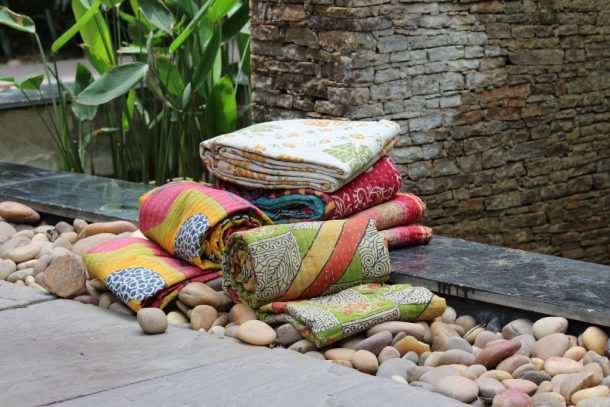The Sanskrit word kontha defines ‘rags.’ One legend links their origins to Lord Buddha and other gods like Brahma and Shiva who used to cover themselves with dresses made from discarded rags that were patched and sewn together. Rags unveil at Indian shrines or bind to tree limbs symbolize prayers and wards off the evil eye. The oldest endure kantha date from the early 1800s and is embroidered with blue, black and red threads that were untangle from sari borders. Because they were reinstate from used garments that had been habitually laundered, the colors tend to be muted. Please see types and process of kantha embroidery below –
Types of Kantha –
Lep kantha are rectangular swaddle heavily padded to make warm coverlets. The whole piece would be stitched in wavy, rippled designs over which elementary embroidery was performed.
Sujani kantha are rectangular pieces of cloth used to make blankets or spreads on ceremonial occasions. It is kind of heavy work done of piece of cloth.
Baiton kantha are square swaddle used for covering books and other valuables. They are carefully patterned with borders of several rows of multi-color designs.
Oaar kantha : In this there are rectangular pillow covers in plain designs with a decorative border sewn throughout the edges.
Archilata kantha : In this there are small, rectangular covers for mirrors or toilet accessories with broad, colorful borders in assorted motifs.
Durjani/thalia kantha : In this there is a small rectangles with a midway lotus design and embroidered borders. Three corners of the rectangle are bending inward to form a wallet.
Rumal kantha : This is used as permeable wipes or plate coverings. These also attribute a central lotus with ornamented borders.
Dorokha or the double-sided kantha : This has either an alike pattern or sometimes a different pattern at the back of the embroidery. So it is veracious a reverse embroidery.
Kantha comprises of the elementary stitch in the language of embroidery – the running stitch. It is the process in which this stitch is used, in divergent arrangements which forms the complex vocabulary of kantha.
Originally it was used to sewn the layers of old saris, to make quilts and was used as a means of showing their thoughts, ideas by both urban and rural women in Bengal.
Kantha Process and Stitches
The process of making kantha embroidery is quite simple but it allows for a vast range of expression. Now a day’s people have used this embroidery form in several ways from cutting-edge contemporary to classic traditional.
The motif is first drawn on paper by hand.
The outline is then hunt down on to a tracing paper. The edges of the pattern are incised with a needle with a distance of 1 mm between each prick. Colored embroidery threads are chosen in accordance with the pattern. All of the threads have code numbers that are eminent for future reference.Cane frames may be used to lengthen the fabric. Larger plastic frames may also be used.
Usually a simple outline is first made on the pattern.Sometimes the patterns are more abstract and are finished all over the fabric, usually to hold 3 or more layers of cloth. These motif are embroidered free-hand without discover. Artisans are skilled enough to stitch evenly spaced spirals or lines. In kantha embroidery there are numerous patterns for borders as well as ‘butis’ or dots to pervade a fabric.
Know more about
Kantha.
Shop Kantha Quilts.

